Sending Signals of Support for Tibet
Mr. Sangay goes to Foggy Bottom.

On October 15, the Trump administration elevated—at least slightly—America’s relationship with the democratic Tibetan exile government by welcoming its leader, Lobsang Sangay, to the State Department for the first time. Robert Destro, the newly appointed special coordinator for Tibetan issues, brought the elected Tibetan leader if not exactly in from the cold then at least in from the coffee shops where American diplomats used to meet him. Officially, the United States considers Tibet part of China and Washington has previously avoided any hint of the kind of official recognition of the Tibetan exile government that meetings in the department might suggest. But now:


Keeping the leader of Tibet’s democratic exile government at a distance no longer makes sense while the United States moves toward greater coordination with Indo-Pacific democracies. However, if Sangay’s step across the State Department’s threshold is to amount to more than a photo op, the United States should include the Tibetan leader in a response to the PRC’s assertive international Tibet agenda.
Tibet’s democracy in exile dates to 2011, when the Dalai Lama transferred his political authority to the government elected from Tibet’s diaspora. “Now we are completely changed from the theocracy of the past,” the Dalai Lama said at the time. “Our decision is a real answer to the Chinese Communist accusation that the whole aim of our struggle is the restoration of the old system.” The Tibetan government based in India, known as the Central Tibet Administration, has executive, legislative, and judicial branches and enjoys jurisdiction over a number of issues. The Dalai Lama however, remains central to Tibetan national identity and therefore the target of PRC efforts to usurp his authority and exert control over Tibetan Buddhism. At a rare Chinese Communist Party (CCP) meeting on the subject of Tibet this past August, Chinese leader Xi Jinping repeated a call to “actively guide Tibetan Buddhism to adapt to the socialist society and promote the Sinicization of Tibetan Buddhism.”
Internationally, Tibet serves as both a means and an end in Beijing’s assault on liberal democratic norms. China presses its positions on Tibet within the United Nations and its bodies, manipulating the Human Rights Council—to which it was just re-elected—and imposing litmus tests related to Tibet throughout the organization. Even history is put at the service of the PRC’s objectives as CCP-approved history has progressively backdated the PRC’s claims to Tibet to “antiquity” just as it has insisted its rights in the South China Sea date to “ancient times.”
In countries with Buddhist traditions, Beijing is on a spending spree, developing and appropriating historic Buddhist sites, coopting Buddhist monks and institutions as a way to gain legitimacy as an authority on Tibetan Buddhism and sow disloyalty to the Dalai Lama. One of the CCP’s top priorities: Gaining the world’s acquiescence to a China-designated successor to the Dalai Lama. The consequences of all this for Tibetans are dire, inside and outside Tibet. Nepal, once a haven for Tibetan refugees, has capitulated to Chinese demands to repatriate fleeing Tibetans and persecute the historic settled Tibetan community. China built Nepal a police academy and according to reports Chinese security officials have operated inside its territory.
Meanwhile, Beijing has continued its aggression on other fronts:
China has escalated its pressure across the disputed border between occupied Tibet and India, leading this past summer to the deadliest clash in decades, while amplifying China’s claim to large areas of Indian territory as “South Tibet.”
After the Dalai Lama visited Mongolia in November 2016, the PRC shut down border trade with Mongolia and imposed fees on exports. Beijing was furious that Ulaanbaatar allowed the Dalai Lama to exercise an authority that Beijing claims by confirming the reincarnation of the most prominent lama in Mongolia’s branch of Tibetan Buddhism. Not only did the use of economic pressure intimidate Mongolia—by December 2016, Mongolian officials were expressing regret for having welcomed the Dalai Lama—but it also sent a signal to other countries of the costs they might face if they fail to acquiesce when the PRC names its own Dalai Lama.
America has made less headway on the priorities of Tibet policy, a Sino-Tibetan dialogue, “meaningful autonomy,” and religious, linguistic and human rights, which are virtually impossible to achieve while China is under Communist rule.
U.S. officials should consider why America’s position on Tibet evolved in stark contrast to Washington’s staunch refusal to recognize the 1940 Soviet annexation of Estonia, Latvia, and Lithuania. Over five decades, the United States maintained contacts with Baltic diplomats and sent other signals of support, even symbolic ones such as hanging the Baltic flags in the State Department lobby. Such moves were judged vital to the Baltic people’s morale, and their countries’ eventual independence, but did not interfere with the conduct of bilateral relations with the Soviet Union. Indeed, one might argue that sticking to principle helped the United States achieve other goals with Moscow.
Such a principled position on Tibet would be of great help today in blunting the PRC’s international Tibet agenda and its impact on democratic norms. Perhaps Mr. Sangay’s visit to Foggy Bottom hints at further innovation in America’s policy. The establishment of the Tibetan democratic government in exile will be the Dalai Lama’s legacy. It is up to the world’s leading democracy to preserve and expand it.

